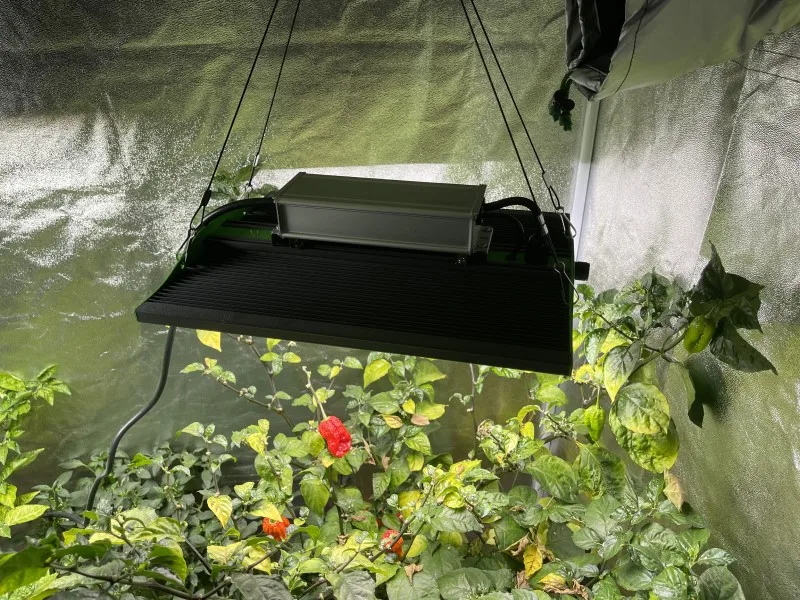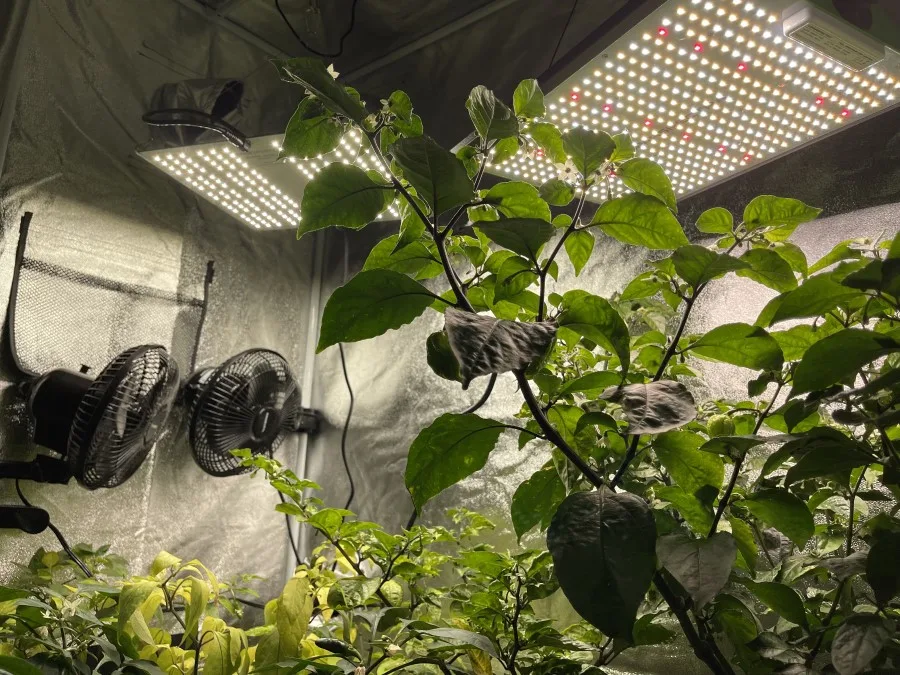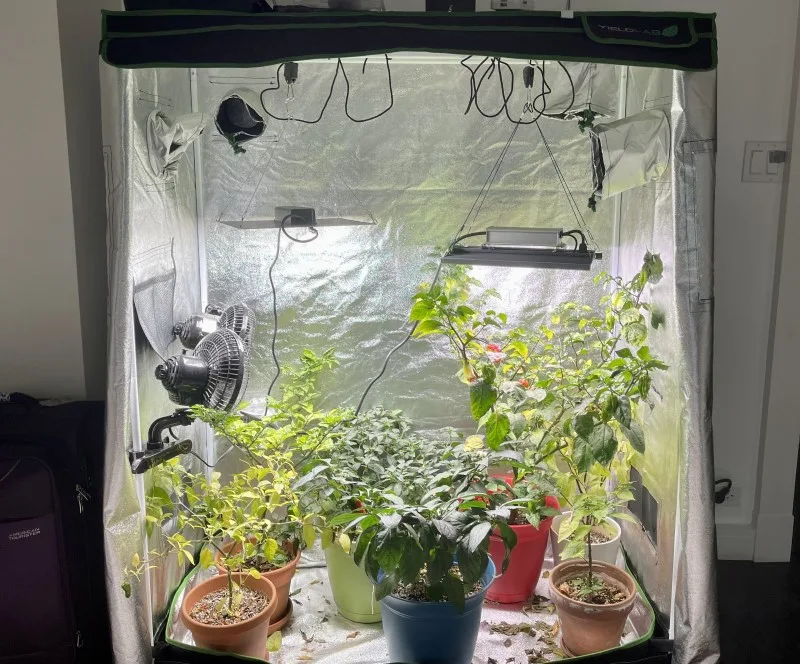Using grow lights is a fantastic way to grow healthy plants indoors. There are many types you can choose from, all of which promote better growth for your plants. But as impressive as they are, can your plants get too much artificial light and end up getting burned?
If used incorrectly, grow lights can burn plants. However, it is the bulbs’ heat that burns the plants, not the light itself. As long as the light is placed at the proper distance from the plant, burns are unlikely to occur.
In this article, we will discuss what damage can occur to your plants from using grow lights, how far away from your plants grow lights should be installed, and ways to keep your plants from burning.
As an Amazon Associate, I earn from qualifying purchases.

Can Grow Lights Burn and Damage Plants?
Grow lights provide an important function, especially in today’s fast-paced world. The demand for food and plants is at an all-time high, and growing indoors is a profitable alternative for many. And many home growers with limited outdoor space rely on grow lights to provide healthy light for their plants to thrive.
But, as useful as they are, can grow lights accidentally burn and damage your plants?
Grow lights can damage and burn your plants if used incorrectly. Grow lights are designed to be safe and are generally less potent than the sun, but your plants can still get burned if the light is placed too close or installed incorrectly.
6 Signs that Grow Lights are Harming Your Plants
Plants can sometimes be quite delicate and require specific conditions to thrive and changing a plant’s temperature, light, or food suddenly can lead to shock.
This shock can eventually lead to the death of your plant. For example, getting burned by a grow light can put a plant into shock. But what are the signs of shock, and what other symptoms will a plant exhibit when overheated by a grow light?
Here are some signs your plant is being harmed by grow lights:
- Discoloration
- Pale leaves
- Dried or crunchy leaves
- Soil dries out quickly
- The plant is hot to the touch
- Stunted growth
Each of these signs indicates your plants are stressed and are possibly being burned. If you notice any of these symptoms, you should determine the cause and may have to adjust your plant’s lighting.

What Causes Grow Lights to Burn Plants?
Generally, you don’t need to be too worried about burning your plants with a grow light. However, it can still happen, so you should understand how to prevent your plants from acquiring burns in the first place.
There are three main reasons that cause grow lights to burn plants: they’re placed too close to the plant, their intensity is too high, or the grow lights are poorly designed.
Placing the Grow Light Too Close to the Plant
Placement is the most likely reason your plants are burning under a grow light. Grow lights emit heat, damaging the membranes along your plant’s leaves and preventing them from adequately absorbing light.
The damage will eventually worsen, resulting in dry or dying leaves and, eventually, the death of the entire plant.
Outdoor plants are far enough away from the sun’s rays that the light isn’t able to do much damage. However, in hotter climates and when there is no shade, sunlight can produce enough heat to burn some plants.
Just like sunlight, grow lights can sometimes burn our plants. If you suspect your grow lights may be too close to your plants, you’re probably right and should adjust them.
If your plants feel hot to the touch or the soil is frequently drying out, your grow light is likely too close to the plants.
Grow Lights’ Heat Intensity is Too High
Another reason your plants might be burning is that your grow light’s intensity setting is too high.
Many types of grow lights have adjustable settings, allowing you to alter how intense you want the lighting to be. If your settings are too high, your plants are far more likely to experience burns.
If your specific grow light doesn’t have intensity settings, it’s likely too close to your plants and needs to be moved further away. You should also consider that certain types of grow lights are stronger than others. For example, LED grow lights are generally more efficient and emit less heat that both fluorescent and HPS grow lights. Check out this post that discusses the heat levels of different types of grow lights and how to decide what option is best for your grow tent.
Grow lights that run for long periods are likely to grow much hotter. That is why grow lights need to be turned off regularly to give your plants a much-needed break from the light and heat. Just be sure your plants are still getting the light they require to grow.
Using a Poorly Designed Grow Light
Not all grow lights are the same. There are hundreds of designs on the market, some of which can be faulty. A poorly designed grow light can result in sparse plant growth and even burns.
Make sure to do your research on grow lights before purchasing one. Read the reviews to look for possible faults and try to fully understand how the product works.
Check out one of our post that outlines how to decide whether to choose between LED and HPS grow lights.
How Far Should Grow Lights Be From Plants To Prevent Burning?
Now that you understand the risks of using a grow light for your plants, it’s time to discuss preventive measures. Grow lights can easily burn a plant if you ignore the placement. So how far away do grow lights need to be placed from your plants?
LED Grow lights should be at least 12-18 inches (30-46 cms) away from your plants, while HPS lights should be placed between 2-6 feet (0.5-2 m) away from your plants. However, each light may be slightly different in terms of power. It’s best to read the instructions in case they have a different placement recommendation.
You should also monitor your plants after installing the grow light. As your plants grow taller, the light may need adjusting, especially if the plants are getting too close to the light. Some plant types are more sensitive than others, but all plants can burn if a grow light is too close.
When in doubt, place your grow light further away. You can always slowly move it closer if your plants need it.

What Other Measures Should You Take To Protect Your Plants From Grow Lights?
Besides placing grow lights further away from your plants, you can protect your plants from burning by watering them regularly, keeping adequate humidity levels, not running the lights 24/7, and lowering the intensity settings.
Here’s a list of measures to keep your plants safe from grow lights:
- Place your grow lights at least 12-18 inches (30-46 cms) from your plants, if you’re using LED lights, and 2-6 feet (0.5-2 m) away if using HPS lights.
- Use a reliable grow light.
- Monitor your plants regularly.
- Adjust your grow light as your plants get taller.
- Lower your grow lights’ intensity settings.
- Keep your plants well-watered.
- Ensure the humidity is high enough for the type of plants you’re growing.
- Check that your grow lights are appropriately wired.
- Don’t run your grow lights 24/7.
If you follow these steps, your plants are far less likely to become burned or damaged by a grow light. However, it’s important to note that placing the light far away from the plant is the most crucial step to keeping your plants safe.
Placing your grow lights on a timer is a great way to ensure your plants get a break from the light and heat. Some lights come with timers—for others, you can purchase a timer that you can plug in to control how many hours your lights are on. Here is the timer that we use to control when our lights are on.
Types of Grow Lights That Are Less Likely to Burn Plants
There are many types of grow lights in indoor gardening, and they’re designed for different situations. Some lights are more potent than others, some are better suited for large industrial warehouses, and others are great for small indoor herb gardens.
Here are some grow light options that will be more gentle with your plants:
- LED lights. LEDs are the most popular grow light choice due to their relatively low cost, easy use, and energy efficiency. These lights use 90% less energy than the average grow light.
- Compact fluorescent. These bulbs produce low greenhouse gas emissions and last a long time. However, these bulbs are hazardous and quite toxic when they break, so be careful when you’re handling them.
- Incandescent lights. The incandescent bulb is one of the oldest light types and can be used to help your plants grow. However, they aren’t quite as powerful and are better suited for smaller areas.
All of these bulbs will be gentle on your plants as long as they’re installed reasonably far above your garden. If you still want to learn more about selecting a grow light, I recommend watching MIgardener’s video on grow lights for beginners. They do a great job going over what to look for in a light and how to use one properly:
Closing Thoughts
Grow lights can certainly burn plants, just like the sun. Luckily, burns from a grow light are easily prevented. The most common reason plants burn under a grow light is because they are placed too close to the plants or the intensity settings are too high.
You can quickly tell if your plants are getting burned from a grow light by their coloration and their temperature. If you think your plant is getting too warm, it’s best to adjust your grow light to avoid burning your plants.
